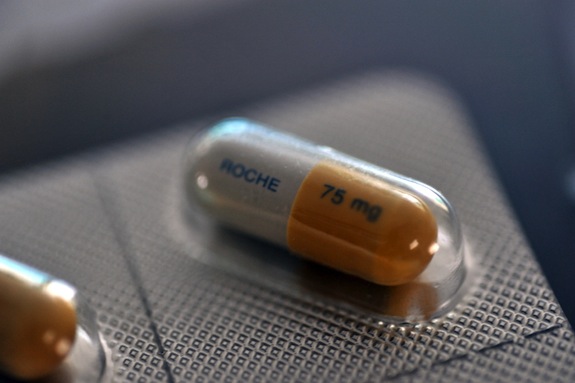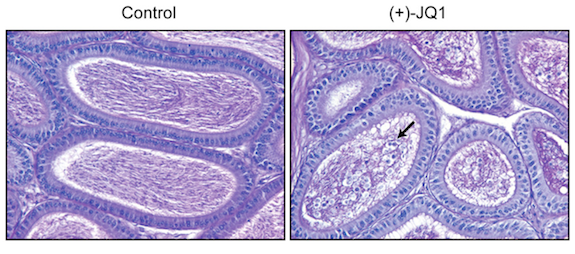Scientists Make Progress Towards a Male Contraceptive Pill
A new molecule originally developed to fight cancer looks to be a promising compound in the search for a male contraceptive
![]()

A new discovery could lay the groundwork for a future oral male contraceptive pill. Photo via Wikimedia Commons/Andrew Wales
The 1960 approval of the first oral contraceptive pill by the FDA for U.S. markets had a wide range of impacts on the nation. The availability of a reversible and reliable contraceptive method was unprecedented in human history; its rapid spread played a crucial role in the sexual revolution, made the cover of TIME Magazine and may have led to more women attending college and graduate school.
Ever since, scientists have been attempting to figure out a way to develop a contraceptive pill for men. Today, researchers from the Dana-Farber Cancer Institute and the Baylor College of Medicine announced that they have identified a chemical compound that could lay the groundwork for a future oral drug that reversibly inhibits male fertility.
“Our findings demonstrate that, when given to rodents, this compound produces a rapid and reversible decrease in sperm count and mobility with profound effects on fertility,” says James Bradner, the senior author of the study documenting the advance, to be published tomorrow in the journal Cell. ”These findings suggest that a reversible, oral male contraceptive may be possible.”
The researchers actually stumbled upon the compound, called JQ1, while on an entirely different mission: trying to find a cure for cancer. The chemical (named after lead chemist Jun Qi) was originally synthesized at Dana-Farber to block the activity of a cancer-causing protein known as BRD4—and in fact, tests in several laboratories have shown it to be a promising treatment for several forms of cancer, including leukemia, multiple myeloma and lung cancer.
“We previously had demonstrated it could inhibit a specific protein called BRD4, but we learned that the molecule also inhibits a related molecule called BRDT,” Bradner says. “BRDT has no role specifically in cancer but is very important for the development of mature sperm, and so we wondered: Could the JQ1 molecule, intended originally for cancer, have activity as a male contraceptive agent?” Computer modeling suggested that the molecule could be effective in this role, but the only way to know for sure would be to test it on live animals.
So Bradner and his colleagues sent samples of JQ1 off to Martin Matzuk‘s lab at Baylor, where his team injected the isolated compound into male mice daily for several weeks and allowed them to mate with females. Some mice required 50 mg per day, some 75 and some 100, but ultimately, the results were all the same: Despite their avid attempts at breeding, JQ1 prevented the mice from producing offspring. Examination showed that the mice had significantly lower sperm counts and sperm with reduced mobility, as compared with a control group of mice that received injections of an inactive fluid.

The testes of the control group (left) were packed with fully mature sperm, while those of mice that had been injected with JQ1 (right) had much lower quantities. The black arrow points to large nucleated cells, which indicate incomplete sperm maturation. Photo via the Dana-Farber Cancer Institute
The molecule works by entering the testes and disrupting spermatogenesis, the process by which sperm mature into functional male gametes. Specifically, JQ1 interferes by binding to a pocket of BRDT, which facilitates the expression of genes important for sperm maturation.
Crucially, the mouse experiments showed that JQ1′s effects were rapid and reversible: In all mice, sometime between a month or two after JQ1 injections were discontinued, normal sperm production and fertility resumed. Additionally, the drug did not affect mating behaviors, alter levels of testosterone or other hormones or produce negative health effects in offspring that were conceived after JQ1 injections were stopped.
All of this does not mean that doctors will start prescribing a male contraceptive pill anytime soon. “At the time we made JQ1, we had not optimized it for its drug-like properties,” Bradner says. “So no, JQ1 is not intended for human use as a male contraceptive agent.” In addition to conducting further experiments to establish the safety and efficacy of JQ1 in humans, researchers would need to produce a form of it that could be delivered orally and enter the bloodstream in order to make a male contraceptive pill.
Still, because the structure of BRDT in mice and humans is similar, the new development is likely to get fans of a potential male contraceptive excited. “The structural and biochemical data provided by this paper are effectively a blueprint for developing a drug-like derivative of JQ1 that could be very potent,” Bradner says. ”JQ1 shows initial promise as a lead compound for male contraception.”
/https://tf-cmsv2-smithsonianmag-media.s3.amazonaws.com/accounts/headshot/joseph-stromberg-240.jpg)
/https://tf-cmsv2-smithsonianmag-media.s3.amazonaws.com/accounts/headshot/joseph-stromberg-240.jpg)